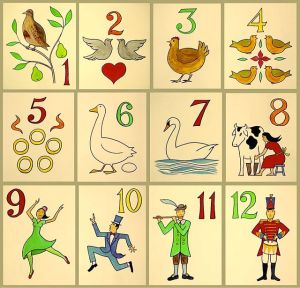 A partridge in a pear tree is the first verse of the Christmas song “The Twelve Days of Christmas“. This is “cumulative song” each verse building on the previous one as a series of increasingly grand gifts is bestowed on the loved one from the first day – Christmas Day (or in some traditions, Boxing Day or St. Stephen’s Day) to the twelfth – the day before Epiphany, January 6.
A partridge in a pear tree is the first verse of the Christmas song “The Twelve Days of Christmas“. This is “cumulative song” each verse building on the previous one as a series of increasingly grand gifts is bestowed on the loved one from the first day – Christmas Day (or in some traditions, Boxing Day or St. Stephen’s Day) to the twelfth – the day before Epiphany, January 6.
The song, first published in England in 1780 as a chant or rhyme, is probably of French origin, indeed it is possible that the single botanical element, the Pear tree (Pyrus communis – Rosaceae), which appears only in the English version, could also indicate a French origin as perdrix (Old French pertriz) carried into the English version. Of course the zoological element, the partridge is not famous for having a tree-dwelling nature so it might be surprising to find one in a pear tree at all.
There are many thousand different pear varieites in cultivation. Dessert pears are widely grown and the RHS recommends several for garden cultivation. Pears are also used to make Perry (like cider from apples) which has a great number of enthusiastic followers.
The verses add a new gift and repeat all the earlier gifts, so that each verse is one line longer than its predecessor:
1 A Partridge in a Pear tree
2 Turtle Doves
3 French hens
4 Calling birds (Colly birds)
5 Gold Rings
6 Geese a laying
7 Swans-a-Swimming
8 Maids-a-Milking
9 Ladies Dancing
10 Lords-a-Leaping
11 Pipers Piping
12 Drummers Drumming
Clearly the giver was not a great plant enthusiast as only the first gift has botanical content, and arguably that only as a perch for a bird!
There are many versions and accompanying tunes, but the familiar one is from a 1909 arrangement of a traditional folk melody by English composer Frederic Austin. You can hear the traditional version sung by the Choir of Wells Cathedral and you can see a rather grand version from the King’s Singers and Mormon Tabernacle Choir if the simple is not enough….
The origins and meaning of the song are obscure but it’s likely to have been a children’s memory and forfeit game. The best known English version was first printed in English in 1780 in a children’s book entitled “Mirth without Mischief”, as a Twelfth Night “memories-and-forfeits” game, where the leader recited a verse, each of the players repeated the verse, the leader added another verse, and so on until one of the players made a mistake, with the player who erred having to pay a penalty, such as offering up a kiss or a sweet.
There seems likely to be no truth in the more recent suggestion that the lyrics were intended as a catechism song to help young Catholics learn their faith, e.g. with the “true love” referring to God, and the partridge in a pear tree to Jesus, and subsequent verses to the two Testaments, the three Theological Virtues, the Four Gospels etc.
There is a clever parody by John Julius Norwich entitled: “12 Days (A Correspondence)” in which the loving Edward actually delivers all these gifts to his true love. It starts sweetly enough when Emily receives, what she describes as an “enchanting, romantic, poetic present – that partridge, in that lovely little pear tree!” And is followed by the delivery of what seems like an endless stream of different types of birds, and then goes from bad to worse with the arrival of “a regiment of shameless hussies” cavorting, followed closely by ten disgusting old men prancing about (some “taking inexcusable liberties with the milkmaids”). It ultimately descends into insanity and an acrimonious law suit issued by the now utterly incensed and enraged Emily! The text is readily available but the book is worth buying!
You can also see and hear DrM’s botanical 12 days for which the orgins are possibly even more strange and obscure than the words of the original song.

